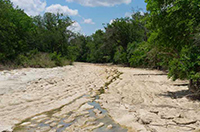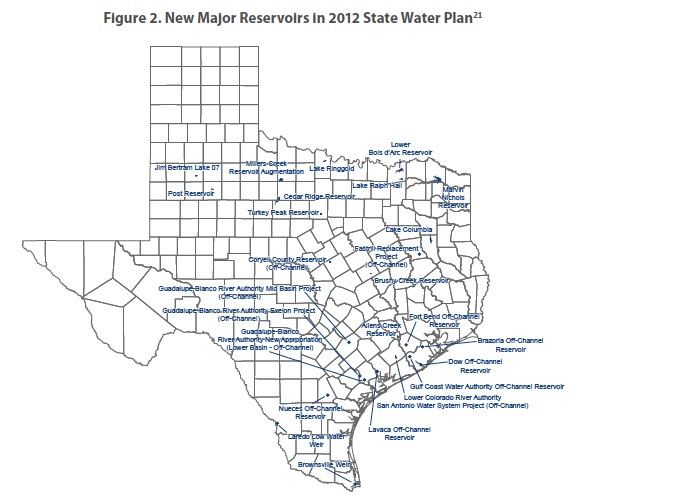ENVIRONMENT TEXAS
 Excessive water withdrawals threaten many of Texas’ most important and beloved rivers. Rivers are a central element of our natural heritage, but wasteful water use is harming wildlife, economically important estuaries, and the basic well-being of our communities.
Excessive water withdrawals threaten many of Texas’ most important and beloved rivers. Rivers are a central element of our natural heritage, but wasteful water use is harming wildlife, economically important estuaries, and the basic well-being of our communities.
Major water users waste billions of gallons each year, even though we have the technology and know-how to use water more efficiently. Unfortunately, the state’s proposed plan for satisfying future water demand favors increased water withdrawals that will further harm our rivers. In many cases, the state has given permission for more water to be withdrawn from rivers than is actually available.
To keep water in our rivers—where it supports wildlife and recreation—Texas should prioritize using water wisely. The five rivers highlighted in this report illustrate the harm to wildlife and ecosystems from water withdrawals. Some rivers have already been devastated by wasteful water use; others are under threat from new water projects that would withdraw more water or fundamentally change the river. Water conservation and efficiency can help protect Texas’ rivers.
Wasteful water use occurs across Texas and throughout the economy, imperiling Texas’ water supply.
- Agricultural, municipal and industrial water consumers withdraw more water from rivers and aquifers than is necessary to irrigate crops, maintain landscaping, and produce electricity. At least 500 billion gallons of water are wasted each year, enough to meet the municipal water needs of 9 million Texans.
- In the past three years, drought has magnified the impacts of wasteful water use. Lack of rain, coupled with withdrawals, has caused river levels to drop.
- Demand for river water is projected to increase in the coming decades.
- Demand for water is expected to rise as Texas adds 21 million residents by 2060. The Texas Water Development Board anticipates that 51 percent of new water supplies will have to come from rivers and streams as the state’s aquifers are increasingly depleted.
- To capture new surface water supplies, the Water Development Board proposes building 26 new reservoirs and constructing new pipelines to tap into existing reservoirs.
Excessive water withdrawals harm rivers by limiting habitat along riverbanks, lowering water quality, and depriving coastal estuaries of the freshwater they need to maintain healthy ecosystems. Rivers across Texas are already suffering from these problems, yet the state is considering new proposals to withdraw more water from rivers.
- Water withdrawals from the Guadalupe River have led to the deaths of 23 birds in the world’s only remaining flock of migrating whooping cranes. Despite flows that are already inadequate, the 2012 water plan includes proposals for more diversions from the river.
- Water withdrawals from the Rio Grande for irrigation and municipal use cause the river to run dry in places. Undiluted pollution and high salinity have created conditions unsuitable for native fish. Though it would seem that the river has no more water to offer, the International Boundary and Water Commission estimates that municipal and industrial withdrawals will increase in the coming years.
- Poor management and overuse cause the San Saba River, a tributary of the Colorado River, to go dry for up to five months each year. Wild pecan trees growing on the banks have died, and the rare Texas pimpleback freshwater mussel is at risk.
- The Trinity River provides half of the freshwater in Galveston Bay, which supports an economically important oyster fishery. Dredging and industrial activity have made the bay vulnerable by increasing salinity levels. Adequate flows from the Trinity River are essential to protecting the bay, but the Houston region has proposed withdrawing more water from the river.
- The Sulphur River has not been damaged by water withdrawals but is threatened by a proposal to create the Marvin Nichols Reservoir to meet growing demand for water from the Dallas- Fort Worth region. Building the reservoir would inundate the river basin upstream from the dam and alter downstream ecosystems.
Investing in water efficiency and conservation measures will help protect Texas’ rivers and is a better choice for meeting the state’s water needs than building new reservoirs and adding pipelines to transfer water to distant consumers.
Texas should prioritize water conservation above increasing supply. The state of Texas should prioritize efficiency improvements over the construction of new reservoirs or pipelines. In turn, regional water authorities should reevaluate their options for meeting projected increases in demand to maximize the use of efficiency measures.
In addition, the state should:
- Establish environmental flows as an official category of water use. The water planning process should include environmental flows as a water need that must be satisfied, on par with other categories of use. In the Guadalupe River, for example, water to support the whooping crane population must be treated as an essential component of the region’s water needs.
- Provide adequate funding for water conservation programs. Recent voter approval of using money from the “rainy day fund” to implement the state water plan and to jumpstart investments in efficiency programs is a strong first step. Half of the funding from the newly created State Water Implementation Fund for Texas should be used for efficiency and conservation improvements. In addition, Texas should use a portion of the fines paid by BP for the Deepwater Horizon oil spill for estuary restoration and to purchase water rights to ensure adequate freshwater flows.
- Improve knowledge of water use and identify savings opportunities through research and data collection.
Download full version (PDF): Down to the Last Drop
About Environment Texas
environmenttexas.org
“Environment Texas is a statewide, citizen-based environmental advocacy organization. We believe there’s something special about Texas — something worth protecting and preserving for future generations. Whether it’s swimming at Barton Springs on a hot day, paddling down the Trinity River or hiking through Big Bend National Park, Texas’ natural wonders enrich our lives in countless ways.”
Tags: Environment Texas, Rivers, Texas, TX, Water








 RSS Feed
RSS Feed